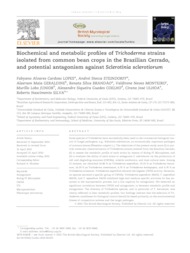Biochemical and metabolic profiles of Trichoderma strains isolated from common bean crops in the Brazilian Cerrado, and potential antagonism against Sclerotinia sclerotiorum.
Biochemical and metabolic profiles of Trichoderma strains isolated from common bean crops in the Brazilian Cerrado, and potential antagonism against Sclerotinia sclerotiorum.
Author(s): LOPES, F. A. C.; STEINDORFF, A. S.; GERALDINE, A. M.; BRANDÃO, R. S.; MONTEIRO, V. N.; LOBO JUNIOR, M.; COELHO, A. S. G.; ULHOA, C. J.; SILVA, R. N.
Summary: Some species of Trichoderma have successfully been used in the commercial biological control of fungal pathogens, e.g., Sclerotinia sclerotiorum, an economically important pathogen of common beans (Phaseolus vulgaris L.). The objectives of the present study were (1) to provide molecular characterization of Trichoderma strains isolated from the Brazilian Cerrado; (2) to assess the metabolic profile of each strain by means of Biolog FF Microplates; and (3) to evaluate the ability of each strain to antagonize S. sclerotiorum via the production of cell wall-degrading enzymes (CWDEs), volatile antibiotics, and dual-culture tests. Among 21 isolates, we identified 42.86 % as Trichoderma asperellum, 33.33 % as Trichoderma harzianum, 14.29 % as Trichoderma tomentosum, 4.76 % as Trichoderma koningiopsis, and 4.76 % as Trichoderma erinaceum. Trichoderma asperellum showed the highest CWDE activity. However, no species secreted a specific group of CWDEs. Trichoderma asperellum 364/01, T. asperellum 483/02, and T. asperellum 356/02 exhibited high and medium specific activities for key enzymes in the mycoparasitic process, but a low capacity for antagonism. We observed no significant correlation between CWDE and antagonism, or between metabolic profile and antagonism. The diversity of Trichoderma species, and in particular of T. harzianum, was clearly reflected in their metabolic profiles. Our findings indicate that the selection of Trichoderma candidates for biological control should be based primarily on the environmental fitness of competitive isolates and the target pathogen.
Publication year: 2012
Types of publication: Journal article
Unit: Embrapa Rice & Beans
Keywords: Cerrado, Feijão, Fungo, Phaseolus vulgaris, Sclerotinia sclerotiorum, Trichoderma
Observation
Some of Embrapa's publications are published as ePub files. To read them, use or download one of the following free software options to your computer or mobile device. Android: Google Play Books; IOS: iBooks; Windows and Linux: Calibre.
Access other publications
Access the Agricultural Research Database (BDPA) to consult Embrapa's full library collection and records.
Visit Embrapa Bookstore to purchase books and other publications sold by Embrapa.

